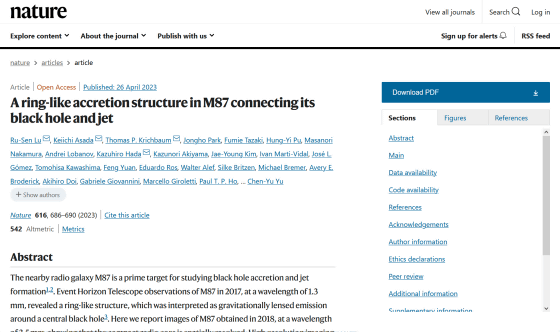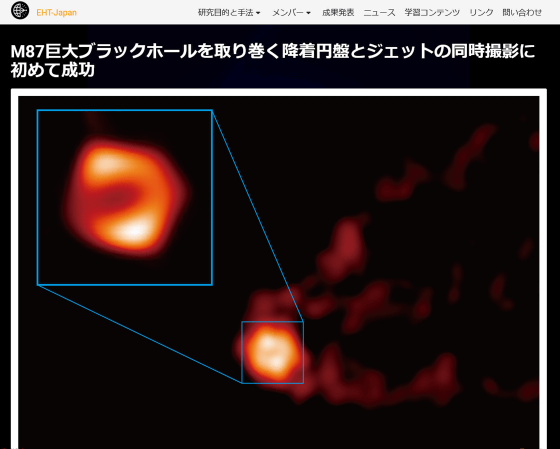Succeeded in putting a black hole and a powerful jet injection in one image for the first time in the world

by Lu et al.2023
A black hole is an ultra- high -density celestial body that exists in outer space and is known to absorb even light due to its strong gravity. I also know that A new international astronomy research team, including the National Astronomical Observatory of Japan, has succeeded in ``capturing a black hole and its jet ejection in one image'' for the first time in the world.
A ring-like accretion structure in M87 connecting its black hole and jet | Nature
https://doi.org/10.1038/s41586-023-05843-w

First successful simultaneous imaging of accretion disk and jet surrounding M87 massive black hole | EHT-Japan
https://www.miz.nao.ac.jp/eht-j/c/pr/pr20230427

First direct image of a black hole expelling a powerful jet | ESO
https://www.eso.org/public/news/eso2305/
Astronomers snap 1st direct image of black hole blasting out a jet | Space
https://www.space.com/black-hole-jet-first-direct-image-m87
Black hole image captures jet of material launching into space | CNN
https://edition.cnn.com/2023/04/26/world/black-hole-jet-direct-image-scn/index.html
The black hole photographed with the jet ejection this time is the supermassive black hole at the center of the M87 galaxy in Virgo. In 2019, the supermassive black hole of M87 was the first image of a black hole to be imaged using the Event Horizon Telescope (ETH), which combines multiple radio telescopes.
Succeeded in the first ever ``imaging of a black hole'', existing in the galaxy M87 55 million light years from the earth with a mass 6.5 billion times that of the sun - GIGAZINE

It is also known that black holes not only inhale matter, but also jet plasma gas etc. at a speed close to the speed of light, and this jet injection promotes star formation across multiple galaxies Research that Results are also reported.
Black hole jets have been imaged before with the Event Horizon Telescope. However, there was no one that captured the part where light does not exist, called the black hole shadow (black hole shadow) , and the jet ejection in one image.
The highest resolution image ever taken of black hole jet injection will be released - GIGAZINE

In 2018, the research team observed the center of M87 in detail using the radio telescope network `` Global Millimeter Wave VLBI Observation Network (GMVA) ' ' in which the ALMA telescope in Chile and the Greenland telescope participate. While ETH observes in the 1.3 mm wavelength band, GMVA observes in the 3.5 mm wavelength band, and although visual acuity is inferior, sensitivity and field of view are superior to ETH.
This is an image that captures the supermassive black hole and jet ejection of M87, which was created using observation data in 2018 and was newly released this time. There is a black hole shadow in the lower left, and jets can be seen extending from both ends of the ring-shaped structure (accretion disk) around it.

by Lu et al.2023
Enlarging the black hole shadow looks like this.

by Lu et al.2023
This is an enlarged image of the accretion disk and the root of the jet. It can be seen that the jets erupt with large opening angles from the south and north sides, and gradually narrow down on the downstream side.

by Lu et al.2023
'Previously, we were able to see the black hole and the distant jet in separate images, but by using the new wavelength band, we can see the black hole,' said Luxen Lu, lead author of the paper and senior scientist at the Shanghai Observatory. We were able to capture both the surrounding structure and the jet at the same time in one panoramic image.'
Capturing images of how jet ejection is ejected from the accretion disk will help clarify the complex mechanisms occurring around supermassive black holes, leading to a better understanding of the jet ejection mechanism.
Dr. Thomas Krichbaum of the Max Planck Institute for Radio Astronomy, a member of the research team, said, 'The improved observational performance obtained by combining the GMVA with the ALMA and Greenland telescopes is an indication of the formation mechanism of jets driven by black holes. also provided new observational findings.'
Dr. Eduardo Roth, also of the Max Planck Institute for Radio Astronomy, said, ``In the future, we plan to observe the area around the black hole at the center of M87 at different radio wavelengths to further study the jet eruption.'' In the years to come, we'll be able to learn even more about what's happening near some of the most mysterious regions of the universe.'
Related Posts:
in Science, Posted by log1h_ik






